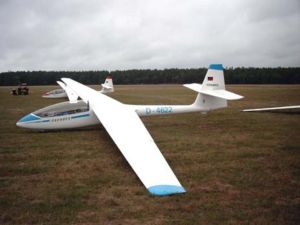PlaneSpottingWorld welcomes all new members! Please gives your ideas at the Terminal.
PZL Bielsko SZD-50
| Type designation | SZD-50-3 |
| Competition class | N/A |
| Number built | ca. |
| Crew | 2 |
| Length | 8.38 m |
| Height | 2.04 m |
| Cockpit width | m |
| Cockpit height | m |
| Wingspan | 16.67 m |
| Wing area | 18.16 m² |
| Aspect ratio | 15.3 |
| Wing profile | |
| Empty mass | ca. 365 kg |
| Water ballast | N/A |
| Maximum mass | 570 kg |
| Wing loading | ca. kg/m² |
| Maximum speed | 215 km/h |
| Speed in rough air | |
| Stall speed | 65 km/h |
| Minimum sink rate | ca. 0.7 m/s at 75 km/h |
| Best glide ratio | ca. 30 at 85 km/h |
| Roll rate (-45 to +45 bank) |
|
The SZD-50-3 Puchacz is a Polish two-place training and aerobatic sailplane designed primarily for gliding clubs.
History
The Puchacz (Eagle Owl) was designed by Dipl-Ing Adam Meus as the successor to the popular Bocian for training. It resembles in some aspects the Jantar 2 but with a shorter span and a second seat. The Puchacz was developed from a prototype known as the SZD-50-1 Dromader which first flew on 21 December 1976; the Puchacz flew a year later. The first production aircraft flew on 13 April 1979 and nine had been built by the beginning of 1980.
Being a moderately priced, versatile, modern two-seater with good handling qualities on the ground and in the air, the Puchacz has become a very popular two-seater sailplane in many countries both for ab-initio and aerobatic instruction.
A number of fatal accidents involving spins have occurred with the Puchacz. Investigation have cleared the design in each case, but the type's reputation has nevertheless been tainted. Its supporters point out that it was designed to obey faithfully all control inputs - including foolish ones. Partial failures at the rudder bar and control sticks have been known to occur, but Airworthiness Directives have been issued for modifications.
Description
The Puchacz is built mainly of fibreglass epoxy sandwich construction protected by polyurethane paint rather than the more usual gelcoat finish. It has cantilever mid-set wings with slight forward sweep, plain ailerons and airbrakes on the upper and lower surfaces. Although it is mainly glassfibre, the fuselage has two wooden frames to which the wings and undercarriage attach. Assembly entails inserting a single main pin to secure the wings in place and a spring-loaded locking pin for the tailplane. Connection of all flight controls is fully automatic.
The landing gear consists of a non-retractable semi-recessed nose wheel, a sprung monowheel mounted behind the centre of gravity with a disc brake and a tailskid which can be replaced by a tail wheel. There are two towing hooks, one in the nose for aero tows and the other mounted on the centre of gravity for winch launching. The tail unit is of glassfibre sandwich, the rudder being fabric-covered.
The two pilots sit under a flush-fitting one-piece cockpit canopy that opens sideways, and have dual controls. The front rudder pedals and the rear seat shell are adjustable. The front instruments are arranged so that they can be easily viewed from the rear seat; a rear instruments panel is also available as an option.
The Puchacz meets both OSTIV and JAR-22 Utility Category certification requirements and is approved for extended aerobatics including inverted flight and rolling manoeuvres.

